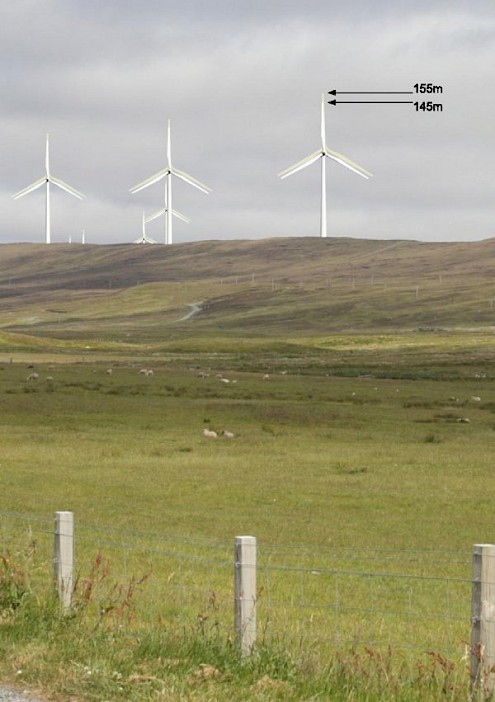Shetland Islands Council planners are assessing Viking Energy’s proposal to build wind turbines slightly larger than those approved originally in April 2012.
The formal consultation on the application has now closed and decisions are expected by the planners and the Scottish Government’s Energy Consents Unit (ECU) in the coming months.
Viking applied in November for an increase of up to 10 metres to the permitted tip height, from the current maximum of 145 metres to 155m (see enclosed image of the visual difference).

The variation application examines how the effects of the increase differ from those of the consented wind farm. The application was not required to re-examine issues relating to the 103-turbine wind farm, which were scrutinised fully by Scottish Ministers before granting approval in 2012.
Viking Energy’s own appraisal of the visual impact of the tip height increase concluded there would be no change to the wind farm’s landscape and visual effects, excluding the effects of turbine lighting. Visual representations of how the turbines would look in different parts of the site can be seen on the Viking Energy website.
In its consultation response, Scottish Natural Heritage (SNH) considered the landscape and visual impacts of the increased tip height and raised no objection, stating that “the increased scale and visibility . . . is unlikely to result in a significant change to the assessed impact of the consented scheme.”
Commenting on SNH’s response, a Viking Energy spokesman said: “We are pleased to note that SNH thinks it unlikely that the larger turbines will result in a significant change to the wind farm’s visual impact, provided that an appropriate aviation lighting scheme can be agreed.”
Viking is in talks with the relevant stakeholders to find a mutually satisfactory outcome to the issue of lights on turbines. The spokesman said: “A number of options are currently being explored, such as radar-activated lighting which only comes on when a low-flying aircraft approaches.”
Viking Energy is confident that a solution can be agreed with the Ministry of Defence to address its concerns about radar coverage. “It is standard practice for wind farms across the UK to have to address potential impacts on aviation and air defence radar,” the Viking spokesman said.
Concerns about an increased impact on birds from larger turbines were also addressed by SNH in its consultation response, concluding that there would be no significant additional impact on key bird species.
Viking Energy is already committed to an extensive Habitat Management Plan to restore damaged peatland and improve bird habitats across various parts of the Shetland Mainland during the lifetime of the wind farm.
Viking is the gateway project for the renewables industry in Shetland, which will diversify the economy and generate wide-ranging employment opportunities.
The application and supporting information relating to the proposed tip height increase is freely available to view or download here at the Viking Energy website.
The consultation responses to the variation application are available on the ECU website by searching for Viking Wind Farm here. It includes all objections and Viking’s responses to those objections.
The Viking project team would welcome any opportunity to explain the application in more detail. Please do not hesitate to get in touch if you have any queries or would like to know more about the variation application or the project more generally. We look forward to hearing from you.